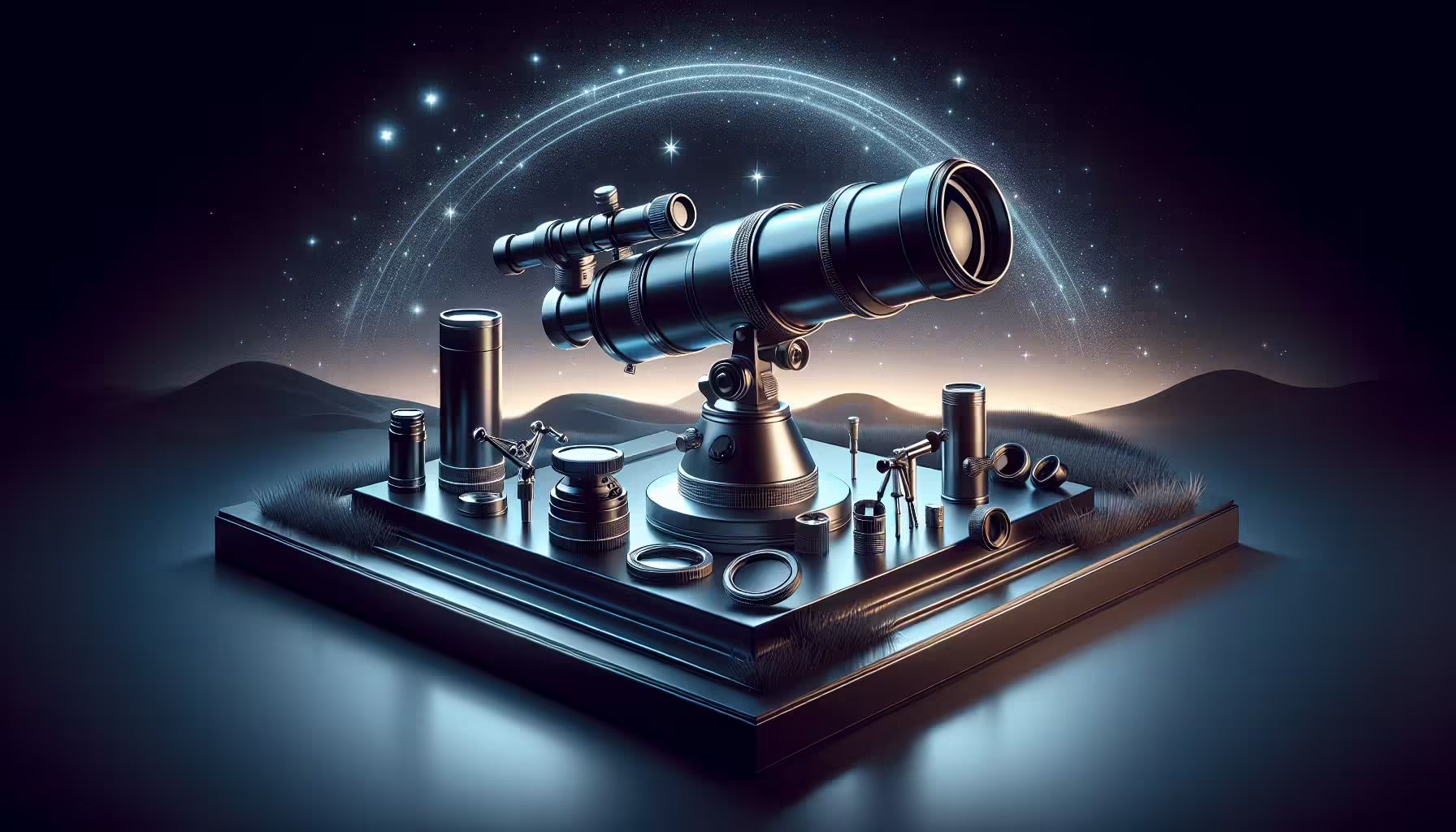What accessories do I need for my telescope? A question that echoes in the mind of every budding stargazer as they embark on a celestial journey. Venturing beyond the confines of our blue planet, peering into the depths of space requires more than just a telescope; there’s a host of tools available that can make your stargazing experience all the more rewarding. In this article, we’ll explore the must-have telescope accessories that can enhance your viewing sessions, improve your observations, and possibly lead you to realms of the universe you hadn’t even imagined.
Table of Contents
Understanding the Basics: A Brief History of Telescope Accessories
When Galileo first lifted his rudimentary telescope to the heavens, he couldn’t have imagined the myriad accessories that would one day accompany these instruments. From the humble beginnings of simple glass lenses, optical technology has advanced leaps and bounds. Over the centuries, our understanding of astronomy has sculpted the evolution of telescope additions, each designed to address specific needs and enhance the viewing experience. Today’s accessories are the fruits of years of astronomical advancements and technological innovations, crafted to make stargazing both accessible and sophisticated.
Current Trends in Telescope Accessories
In recent years, there’s been a significant uptick in amateur astronomy, spurred by social media and digital sharing platforms that allow enthusiasts to post their captures of cosmic phenomena with ease. This surge has led to a booming market for telescope accessories. Manufacturers are quick to adopt cutting-edge technologies, integrating augmented reality to assist in sky navigation or developing adaptable mounts for smartphones, thus merging the digital with the telescopic world. The ease of online shopping has also allowed niche accessories to find a global audience, making it easier than ever for you to equip your telescope with the latest enhancements.

This image is property of pixabay.com.
Key Telescope Accessories You Can’t Do Without
Now, let’s dig into the key accessories that could take your stargazing exploits from satisfactory to spectacular.
Eyepieces: The Window to the Universe
Eyepieces expand your viewing options by providing different magnification levels and fields of view. High magnification eyepieces are perfect for observing details on planets, while low magnifications are more suited for deep sky objects like galaxies and nebulae. Owning a variety of eyepieces allows you the flexibility to switch views tailored to the celestial object you’re observing.
Barlow Lenses: Doubling Down on Magnification
The Barlow lens is the unsung hero in the world of telescope accessories. It effectively doubles or triples the magnification of any given eyepiece without sacrificing image quality. Investing in a good Barlow lens means fewer eyepieces are necessary to achieve a comprehensive range of magnification.
Star Diagonals: Comfortable Viewing Angles
For those of you who appreciate comfort, star diagonals are a godsend. They adjust the viewing angle, making it much easier to enjoy extended observation periods without neck strain. These are particularly beneficial when observing objects that are high in the night sky.
Finderscopes: Spotting the Unseen
Finderscopes aid in initially locating celestial objects. They offer a wide field of view, allowing you to align your telescope with a target before a detailed observation. Red dot finderscopes are popular for their simplicity and accuracy, projecting a red dot onto the sky, pointing you to your desired object.
Filters: Enhancing Celestial Details
Different types of filters cater to various astronomical needs. Lunar filters reduce brightness and enhance contrast while observing the moon. Deep-space filters help in observing nebulae by blocking out light pollution. Solar filters are essential when observing the sun to protect both your eyes and equipment.
Exploring Further: Additional Accessories for the Enthusiast
Once you have the basics covered, you might want to consider upgrading with some additional gear.
Mounts and Tripods: Stability Matters
A solid mount or tripod can make or break your stargazing experience. There’s nothing more frustrating than a shaky image caused by an unstable setup. Equatorial mounts are popular for their intuitive design, making tracking celestial movements straightforward.
Dew Shields and Heaters: Battling the Elements
Dew can be a significant nuisance, often blurring your image. Dew shields and heaters help keep moisture at bay, ensuring you have clear views without interruption. These are particularly handy during those long, damp nights in search of faint celestial objects.
Camera Adapters: For the Aspiring Astrophotographer
With the surge of amateur astrophotography, camera adapters for telescopes have skyrocketed in popularity. These adapters allow you to attach your camera to the telescope, opening up a whole new world of possibilities, from capturing crisp lunar details to long-exposure shots of galaxies.

This image is property of pixabay.com.
Comparative Insight: Different Perspectives on Telescope Accessories
It’s worthwhile to compare different perspectives on how various accessories enhance the stargazing experience. Here’s a brief comparison table detailing the benefits of each type of accessory:
| Accessory | Function | Benefit |
|---|---|---|
| Eyepieces | Magnification options | Versatility in observation |
| Barlow Lenses | Extends eyepiece range | Cost-effective magnification |
| Star Diagonals | Adjusts viewing angle | Comfort in viewing |
| Finderscopes | Initial object location | Ease of navigation |
| Filters | Enhances specific observations | Improved clarity and detail |
These accessories collectively work to elevate your stargazing endeavors, enabling a deeper connection with the night sky.
Assessing the Impact of Telescope Accessories
Each of these accessories can render a noticeable improvement in your viewing experience, leading to deeper enjoyment and understanding of astronomy. Consider the contentment of effortlessly tracking planets across the sky with a top-notch mount, or the awe of viewing Saturn’s rings in stark detail through a quality eyepiece. The right combination of accessories impacts not just what you see, but how you experience our vast universe.

This image is property of pixabay.com.
Looking Forward: The Future of Telescope Accessories
Predicting the future of telescope accessories can be as tantalizing as star-gazing itself. One can foresee a future where smart telescopes integrate AI, allowing for automatic celestial object recognition and tracking, potentially revolutionizing the way!
Additionally, advancements may lead to more cost-effective materials, making high-quality accessories more accessible to a broader audience. As technology continues to evolve, so will the integration of telescopic accessories with digital interfaces, further enhancing user experience both for observation and astrophotography.
The Broader Implications
The evolution and widespread use of telescope accessories have broader implications not just for hobbyists but for the field of astronomical research. As this equipment becomes more advanced and accessible, it fuels greater citizen science initiatives, where amateur astronomers contribute valuable data to scientific studies, particularly in monitoring transient events like supernovae and asteroid comets.
In conclusion, equipping your telescope with the right accessories is akin to having the right tools before setting out on an expedition. Accessories such as eyepieces, Barlow lenses, filters, and more, not only improve what you can see but also how you interact with the cosmos. These tools not only expand your observational capabilities but enrich the entire stargazing experience, transforming your telescope into a window to the universe.
As you ponder over the impressive array of gear available, what captures your imagination the most? Consider investing in a few choice accessories and prepare to be amazed at how they transform your next night under the stars. And remember, in the vast expanse of the sky, there’s always something new to discover. What will your next celestial find be?

